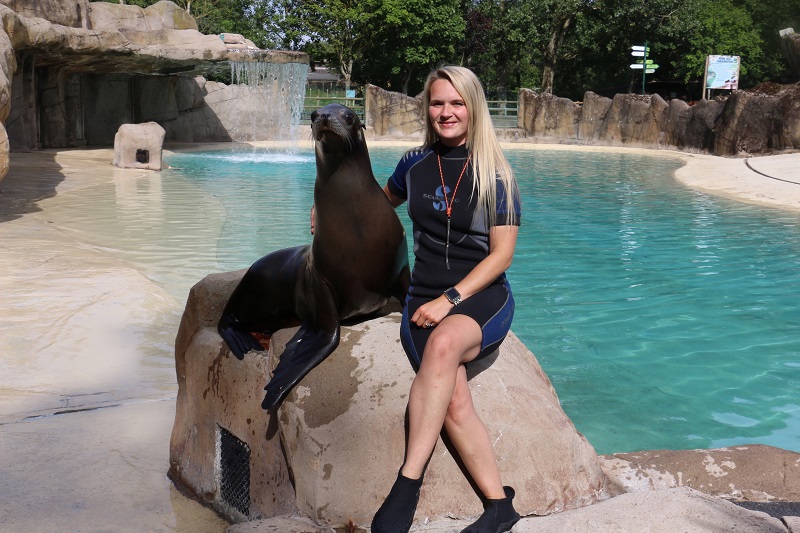Blackpool Zoo keeper secures prestigious Fellowship
A talented Blackpool Zoo keeper and animal trainer fought off stiff competition from almost 2000 other applicants to further her in-depth research into the whisker movement of seals and sea lions.

Having already achieved a first-class honours BSc, a MSc Distinction and a PhD, Dr Alyx Milne has now been accepted onto the coveted BBSRC Discovery Fellowship, following a rigorous year-long selection process.
The Discovery Fellowship will support her new research titled “Super Seal Sense: Whisker movement strategies in Pinnipeds” and will be funded by Biotechnology and Biological Sciences Research Council (BBSRC) and Manchester Metropolitan University. Alyx will be completing her at project at Manchester Metropolitan University where she has also worked as a Researcher and Associate Lecturer.
Liverpool-born Dr Alyx said: “The application process was a long hard task with a year of zoom interviews, intense presentations and numerous documents submitted.
“I still can’t quite believe I was one of a few successful candidates when there were so many worthy applicants. I’m thrilled to be able to continue my research, with the fantastic support of my friends at the Zoo, and obviously Manchester Metropolitan University and BBSRC.”
Dr Alyx’s PhD research showed for the first time that sea lion whiskers were moveable, using specialist muscles, where it had previously been thought to be largely down to the animal’s head positioning.
With this discovery and the new technology available, she will go on to explore more about how whiskers are moved, controlled and used for touch sensing, much like human fingertips.
She added: “My research so far has shown that California sea lions use their whiskers for task-specific movements such as identifying the size or texture of an object, so the next step will be to investigate whether other species also do this.”
“Although many researchers assume whiskers do active touch sensing, it has never been quantitatively investigated in any animal.”
Exploring this subject in such depth is a complex challenge, but one that could bring benefits to numerous diverse fields, as Dr Alyx explains:
“At Manchester Metropolitan University’s’ Ecology and Environment Research Center (EERC) I will design training tasks and use state-of-the-art 3D imaging to compare differences between pinniped whiskers and the efficiency of their sensing.
“I’ll be able to explore the effects of whisker shape using mechanical models and underwater robot sensors.
“The scientific results of my research will be submitted to high profile journals and hopefully present at international conferences, including: International Animal Training Conference, World Marine Mammal Conference and The Association for the Study of Animal Behaviour.
“Raising two young children and with my husband often away for extended periods with the military, I’m exceptionally proud of what I’ve achieved so far in my career, and I’m so excited about the opportunities that lie ahead with the Fellowship.”
Darren Webster, Zoo Director is hugely proud of Alyx and she has his full backing in continuing her research. He said: “Alyx is a hugely respected member of the zoo community and her dedication to her studies is exemplary.
“Since joining our team 12 years ago she has become a firm favourite with visitors, staff and, of course, the sea lions. She works incredibly hard and gives 100 per cent to everything she does, which is why she is so successful.
“This fellowship is an amazing opportunity and she thoroughly deserves her place. I look forward to seeing how she furthers her research into this fascinating field.”
Follow the research here:
Instagram: @supersealsense
Twitter: @supersealsense
Website: www.supersealsense.wordpress.com
Facebook: @supersealsense
Dr Alyx Milne has also written and co-authored several well-received papers from her PhD research:
Milne, A.O., Smith, C., Orton, L.D., Sullivan, M.S. and Grant, R.A. (2020). Pinnipeds orient and control their whiskers: A study on Pacific walrus, California sea lion and Harbor seal. J Comp Physiol A. https://doi.org/10.1007/s00359-020-01408-8
Milne, A.O., Muchilinski, M., Orton, L.D., Sullivan, M.S. and Grant, R.A. (2021). Comparing vibrissal morphology and infraorbital foramen area in Pinnipeds. The Anatomical Record,1–12. https://doi.org/10.1002/ar.2468312
Dougill, G., Starostin, E.L., Milne, A.O., van der Heijden, G.H.M., Goss, G.A. and Grant, R.A. (2020). Ecomorphology reveals Euler spiral of mammalian whiskers. Journal of Morphology. 2020;281:1271–1279. https://doi.org/10.1002/jmor.21246
Milne, A.O., Jones G.C., Black, C.H, Orton, L.D., Sullivan, M.S. and Grant, R.A. (In Submission) Active touch sensing in the California sea lion (Zalophus californianus). Journal of Experimental Biology.
And from her MSc:
Milne, A.O. and Grant, R.A. (2014). Characterisation of whisker control in the California sea-lion (Zalophus Californiaus) during a complex, dynamic sensorimotor task. J Comp Physiol A. https://doi.org/10.1007/s00359-014-0931-1